It looks like you're using an Ad Blocker.
Please white-list or disable AboveTopSecret.com in your ad-blocking tool.
Thank you.
Some features of ATS will be disabled while you continue to use an ad-blocker.
share:
Working with stone is certainly hard work and at the same time therapeutic, with the end result of a finished job or product being the reward. Using
stone for everything from paving to building walls and even roofs has been around for thousands of years. Like wood, it has been one of the key
ingredients for the construction of houses, churches, castles and even roads. The beauty of stone is unquestionable, with every part of the globe
naturally producing stone of varying unique colours, textures, densities and ultimately some of the finest material for man to use. For this thread
(my first) I'll use mostly links from wiki and yt, as there is no conspiracy in stone (except for the odd
oopart maybe!).
Wikipedia
Granite and bluestone "pitchers" or blocks on the other hand need to be cut or traced into shape before use. Separating a large rock like this involves drilling holes across the rock, about 4 to 6 inches apart, depending on the size, then inserting "plugs and feathers" which are tapped one by one with a mallet or hammer. Once the blocks are small enough to man handle, a bolster (or a carbide tipped tracer is preferable) can be used to get the ideal size wanted. Cutting the stone with a saw is fine for a modern effect (which then needs to be polished) but doesn't give the stone a natural finish. A carbide pitching tool, is then used to remove the drill hole marks left in the stone from the plug and feather, and finally a carbide pointing tool is used to knock any protrusions or rough spots off in order to even the stone out. Carbide tipped tools are more commonly used on harder stone for their durability.
Stone is classified into three main groups: Igneous (granite, bluestone), Sedimentary (sandstone, limestone) and Metamorphic (marble, slate) as well as a whole range of sub-categories which allow any of the above stones to cross over into the three main categories. The slate which I work with is technically a "mudstone" but rather than try and give geology lessons, as I'm no geologist, I'm more than happy to hear from these guys as well as masons in regard to details or different work practices.....after all, we're all here to learn!
Paving: This can be done in many different ways such as laying cut tiles in a uniform fashion, herringbone i.e. a consistent pattern of tiles of varying sizes, flagstones which are simply stepping stones randomly or evenly spread, and my favorite which is crazy paving, basically laying the stone with It's natural edges intact and only minor trimming to fit together as a jigsaw puzzle. The thicker the stone, the better as moisture from the ground wont affect or show through as it can with thin tiles. Paving can be laid or "bedded" in packing sand (generally reserved for flagstones or nothing thinner than about 40mm) or mortar (sand and cement, generally mixed either 2 or 3 parts washed sand to 1 part cement). Sometimes a "crusher dust" or granitic sand is added to the mix for strength.....but I'll keep it simple! You can either "panel beat" the edges of the stone with a hammer (more natural) or cut some edges of the stone with a grinder and diamond blade, which gives you very tight joints (preferably cut from the underside of the stone, not all the way through and snap it at the face). For thin paving (12mm to 40mm average) the height from ground surface to stone face is around 70mm to 90mm generally speaking, but the strength or type of stone being used will dictate what is more or less feasible.
Thinner stone generally has a concrete base (sand, stone aggregate mix) laid first. Once cured, mortar is then used to bed the stone. The base is the most important, and firming up of the ground by using compacted sand or "blue metal" (road base bluestone chips) is an ideal way to create the right base to lay paving. Note: washed sand and packing (brickie) sand are two different things. Washed sand is like a beach sand and slightly "aerates" the mortar and mixes cleanly also adding to the final appearance if used as grout. Bondcrete can be used to make the mix "tacky" and pigment or oxide can alter the colour of your mix (brickie sand also can be used in smaller quantities to alter colour and add tack). Fall is another important factor, as you don't want water running back towards your house (if that's where your paving) and a drop of about 15mm per lineal meter should suffice. As for grout, you can either make a fresh mix with colour or pebbles (experiment a little!), or use the same base mix as the stone is laid, filling the gaps as you go along.
(continued next post)
Wikipedia
I've been involved in masonry for 7 years now, with the majority of my work being the extraction and preparation of raw slate for other masons and landscapers to use. Slate is a metamorphic rock made up of sedimentary layers which can be split by hand using the most basic tools: mallet and bolster to separate the stone into veneer sheets which can then be used in any of the above fashions. It can also make walling quite easy as veneer sheets are already extremely flat, therefore eliminating the need for pitching and pointing the stone to create a flat surface to lay.
Quarrymen split veins, or sheets of rock, and extract the resulting blocks of stone from the ground. Sawyers cut these rough blocks into cubes, to required size with diamond-tipped saws. Banker masons are workshop based, and specialize in carving stones into intricate geometrical shapes required by a building's design. They can produce anything from stones with simple chamfers to tracery windows, detailed mouldings and the more classical architectural building masonry. When working a stone from a sawn block, the mason ensures that the stone is bedded in the right way, so the finished work sits in the building in the same orientation as it was formed on the ground. The basic tools, methods and skills of the banker mason have existed as a trade for thousands of years. Carvers cross the line from craft to art, and use their artistic ability to carve stone into foliage, figures, animals or abstract designs. Fixer masons specialize in the fixing of stones onto buildings, using lifting tackle, and traditional lime mortars and grouts. Sometimes modern cements, mastics and epoxy resins are used, usually on specialist applications such as stone cladding. Metal fixings, from simple dowels and cramps to specialized single application fixings, are also used. The precise tolerances necessary make this a highly skilled job. Memorial masons or monumental masons carve gravestones and inscriptions. The modern stonemason undergoes comprehensive training, both in the classroom and in the working environment. Hands-on skill is complemented by intimate knowledge of each stone type, its application and best uses, and how to work and fix each stone in place. The mason may be skilled and competent to carry out one or all of the various branches of stone masonry. In some areas the trend is towards specialization, in other areas towards adaptability.
Granite and bluestone "pitchers" or blocks on the other hand need to be cut or traced into shape before use. Separating a large rock like this involves drilling holes across the rock, about 4 to 6 inches apart, depending on the size, then inserting "plugs and feathers" which are tapped one by one with a mallet or hammer. Once the blocks are small enough to man handle, a bolster (or a carbide tipped tracer is preferable) can be used to get the ideal size wanted. Cutting the stone with a saw is fine for a modern effect (which then needs to be polished) but doesn't give the stone a natural finish. A carbide pitching tool, is then used to remove the drill hole marks left in the stone from the plug and feather, and finally a carbide pointing tool is used to knock any protrusions or rough spots off in order to even the stone out. Carbide tipped tools are more commonly used on harder stone for their durability.
Stone is classified into three main groups: Igneous (granite, bluestone), Sedimentary (sandstone, limestone) and Metamorphic (marble, slate) as well as a whole range of sub-categories which allow any of the above stones to cross over into the three main categories. The slate which I work with is technically a "mudstone" but rather than try and give geology lessons, as I'm no geologist, I'm more than happy to hear from these guys as well as masons in regard to details or different work practices.....after all, we're all here to learn!
Paving: This can be done in many different ways such as laying cut tiles in a uniform fashion, herringbone i.e. a consistent pattern of tiles of varying sizes, flagstones which are simply stepping stones randomly or evenly spread, and my favorite which is crazy paving, basically laying the stone with It's natural edges intact and only minor trimming to fit together as a jigsaw puzzle. The thicker the stone, the better as moisture from the ground wont affect or show through as it can with thin tiles. Paving can be laid or "bedded" in packing sand (generally reserved for flagstones or nothing thinner than about 40mm) or mortar (sand and cement, generally mixed either 2 or 3 parts washed sand to 1 part cement). Sometimes a "crusher dust" or granitic sand is added to the mix for strength.....but I'll keep it simple! You can either "panel beat" the edges of the stone with a hammer (more natural) or cut some edges of the stone with a grinder and diamond blade, which gives you very tight joints (preferably cut from the underside of the stone, not all the way through and snap it at the face). For thin paving (12mm to 40mm average) the height from ground surface to stone face is around 70mm to 90mm generally speaking, but the strength or type of stone being used will dictate what is more or less feasible.
Thinner stone generally has a concrete base (sand, stone aggregate mix) laid first. Once cured, mortar is then used to bed the stone. The base is the most important, and firming up of the ground by using compacted sand or "blue metal" (road base bluestone chips) is an ideal way to create the right base to lay paving. Note: washed sand and packing (brickie) sand are two different things. Washed sand is like a beach sand and slightly "aerates" the mortar and mixes cleanly also adding to the final appearance if used as grout. Bondcrete can be used to make the mix "tacky" and pigment or oxide can alter the colour of your mix (brickie sand also can be used in smaller quantities to alter colour and add tack). Fall is another important factor, as you don't want water running back towards your house (if that's where your paving) and a drop of about 15mm per lineal meter should suffice. As for grout, you can either make a fresh mix with colour or pebbles (experiment a little!), or use the same base mix as the stone is laid, filling the gaps as you go along.
(continued next post)
(continued)
Finally, a sponge and clean water is used to wipe any excess mortar off the stone, then brushed or swept when dry. Some people use a 20 to 1 mix of hydrochloric acid (20 parts water, 1 part acid) which is poured over the finished job, swept with a broom or brush, wait until excess mortar "fizzes", then wash with clean water. Note: NEVER use the acid mix on limestone or travertine as it will destroy the surface of this type of stone!


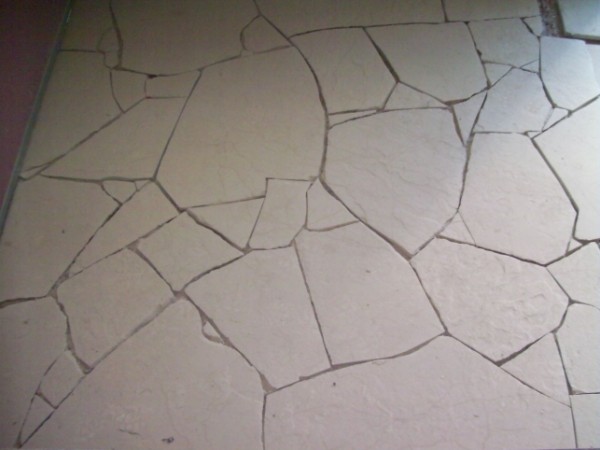

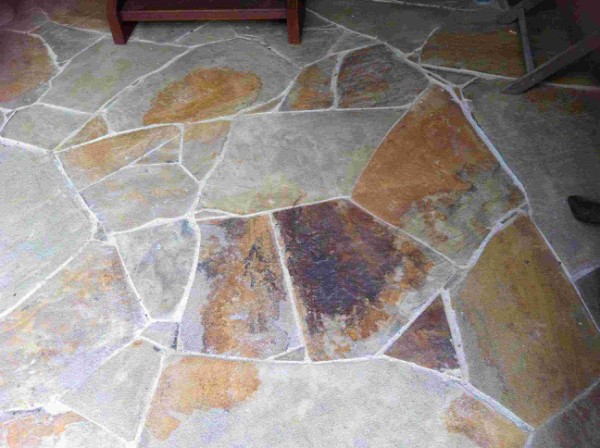
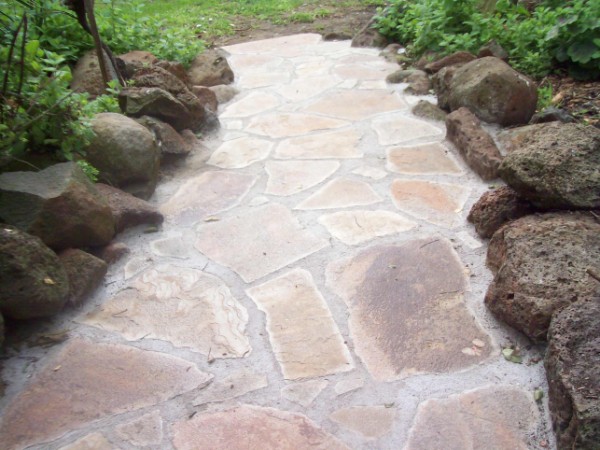 Walling: Traditionally, walling stone is layed in the same orientation as it has been quarried (mainly sanstone) as It's
the best way to ensure longeivity and helps to avoid problems such as "case hardening" (outer layer becomes harder than inner layer and veneers off)
which happens after a period of time, decades usually. "Salt damp" is also a problem with these types of stone where the silicates which bind the
stone break down allowing it to disintegrate. The two above problems occur when there's a lack of drainage for water as well as direct sun light over
a long period of time. Granite and bluestone, even some limestone are excellent for walling as they're extremely hard and robust. Any slate being
used must always be laid with the grain horizontal, as moisture, heat and frost will allow any layer to "pop" and seperate. Mortar mixes for walls
can vary, and generally lime is added to the mix for "tack and strength". More sand is also added to the mix, and typically might read: 1 part
cement, 1 part hydraulic lime, 5 to 6 parts sand. The more cement that is used in a mortar mix adds to strength, but shrinkage or separation of mortar
from stone is more profound allowing moisture to get in which ultimately can weaken the wall. In history, lime mortar was the prominent substance used
for locking stone into place, but with modern day cement (Portland cement in particular which contains about 80-90% lime mixed with various clay
additives) lime mortar is rarely if ever used unless to patch up or recreate an older styled wall or building. The other problem with lime is
"leaching", where the lime will absorb into the stone and show rather ugly white stains around the face of the stone, in particular bluestone. One
little bonus with hydraulic lime is you can mix a big batch and as long as It's kept topped with water (lime just below the water surface) it will
never set! Just stir, use, and top up with water. It can even be used to render over brick work, as long as It's not near extreme heat such as a
fireplace as that can cause it to "blow out" or shatter! Note: Foundation or footing is important here. A couple of inches to 6 inches deep, again
depending on the size of the wall, with a row of stone bedded in the foundation is a good start. Then work from a corner up, and out, basically making
a "two dimensional pyramid", mixing larger, longer pieces ajoining smaller pieces, so as the stone face has a random looking appearance and not like
bricks! It's all personal preference though.
Walling: Traditionally, walling stone is layed in the same orientation as it has been quarried (mainly sanstone) as It's
the best way to ensure longeivity and helps to avoid problems such as "case hardening" (outer layer becomes harder than inner layer and veneers off)
which happens after a period of time, decades usually. "Salt damp" is also a problem with these types of stone where the silicates which bind the
stone break down allowing it to disintegrate. The two above problems occur when there's a lack of drainage for water as well as direct sun light over
a long period of time. Granite and bluestone, even some limestone are excellent for walling as they're extremely hard and robust. Any slate being
used must always be laid with the grain horizontal, as moisture, heat and frost will allow any layer to "pop" and seperate. Mortar mixes for walls
can vary, and generally lime is added to the mix for "tack and strength". More sand is also added to the mix, and typically might read: 1 part
cement, 1 part hydraulic lime, 5 to 6 parts sand. The more cement that is used in a mortar mix adds to strength, but shrinkage or separation of mortar
from stone is more profound allowing moisture to get in which ultimately can weaken the wall. In history, lime mortar was the prominent substance used
for locking stone into place, but with modern day cement (Portland cement in particular which contains about 80-90% lime mixed with various clay
additives) lime mortar is rarely if ever used unless to patch up or recreate an older styled wall or building. The other problem with lime is
"leaching", where the lime will absorb into the stone and show rather ugly white stains around the face of the stone, in particular bluestone. One
little bonus with hydraulic lime is you can mix a big batch and as long as It's kept topped with water (lime just below the water surface) it will
never set! Just stir, use, and top up with water. It can even be used to render over brick work, as long as It's not near extreme heat such as a
fireplace as that can cause it to "blow out" or shatter! Note: Foundation or footing is important here. A couple of inches to 6 inches deep, again
depending on the size of the wall, with a row of stone bedded in the foundation is a good start. Then work from a corner up, and out, basically making
a "two dimensional pyramid", mixing larger, longer pieces ajoining smaller pieces, so as the stone face has a random looking appearance and not like
bricks! It's all personal preference though. 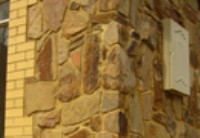

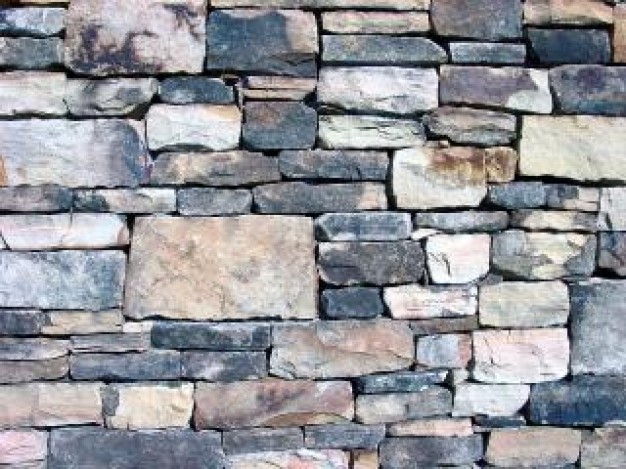
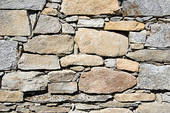 Drystone: Drystone or stacked stone is certainly one of the oldest forms of walling, and simply involves stacking the stones on top of each other
using "shims" or small wedges of stone to interlock each preceeding piece. Larger stones are generally used at the base, and at certain points mid
way up the wall, slightly longer pieces are used to tie in the front to the back of the wall. Although there is no hard and fast way to buid a wall
like this, constant turning and re-aranging of stone is required to get the best fit and the wall must ALWAYS lean slightly back. Capping the wall is
the final part, and involves stacking heavier stones on top to help lock the wall as well as make it aesthetically pleasing. A retaining wall for
example, needs to be constructed just below the level of ground that It's banked up against, as to allow water to flow over the wall during heavy
rains. A free standing wall should resemble an "A" shape if viewed from one end looking along the wall and there are frames or templates (similar to
a large saddle horse) which can be easily made from wood to assist in keeping it uniform. A drystack-mortar finish is slightly more preferable to
masons I know simply because dressing the inner portions of stone help lock everything together, leaving the outer wall looking natural and saving
time (as most people want things done yeterday, not next week!). The beauty of drystone walls is you can use any type of rocks you can find around the
place, especially in the country or rural parts, and involves little to no stone work, other than the actual stacking.
Drystone: Drystone or stacked stone is certainly one of the oldest forms of walling, and simply involves stacking the stones on top of each other
using "shims" or small wedges of stone to interlock each preceeding piece. Larger stones are generally used at the base, and at certain points mid
way up the wall, slightly longer pieces are used to tie in the front to the back of the wall. Although there is no hard and fast way to buid a wall
like this, constant turning and re-aranging of stone is required to get the best fit and the wall must ALWAYS lean slightly back. Capping the wall is
the final part, and involves stacking heavier stones on top to help lock the wall as well as make it aesthetically pleasing. A retaining wall for
example, needs to be constructed just below the level of ground that It's banked up against, as to allow water to flow over the wall during heavy
rains. A free standing wall should resemble an "A" shape if viewed from one end looking along the wall and there are frames or templates (similar to
a large saddle horse) which can be easily made from wood to assist in keeping it uniform. A drystack-mortar finish is slightly more preferable to
masons I know simply because dressing the inner portions of stone help lock everything together, leaving the outer wall looking natural and saving
time (as most people want things done yeterday, not next week!). The beauty of drystone walls is you can use any type of rocks you can find around the
place, especially in the country or rural parts, and involves little to no stone work, other than the actual stacking.
(continued next post)
Finally, a sponge and clean water is used to wipe any excess mortar off the stone, then brushed or swept when dry. Some people use a 20 to 1 mix of hydrochloric acid (20 parts water, 1 part acid) which is poured over the finished job, swept with a broom or brush, wait until excess mortar "fizzes", then wash with clean water. Note: NEVER use the acid mix on limestone or travertine as it will destroy the surface of this type of stone!










(continued next post)
(continued)
Capping: This is used to finish a wall, whether it be dry stack or mortar joints and you can use thick slabs laid flat on top of the stone, or laid vertically in the case of many old dry stack walls. If laid flat, a nice rough natural edge is great. The slate I use keeps a natural oxidized colour that's quite a bit darker than the stone face or surface. You can use single rectangular pieces if they're wide enough, or even finish the wall with a crazy paving type finish, with the straightest edges facing out and the gaps filled behind with smaller, random pieces.
A rake can be used to shape a cut edge and bull nosing finishes with a rounded, polished edge generally used on uniformed, mortar or dry mortar walls. Some people use a router for bull nosing but I prefer the angle grinder, as the router needs to run along the surface of the stone and if It's not honed (polished) can cause it to bounce and ruin the effect. To do this, simply measure the thickness of stone i.e. if the stone is 50mm thick, draw a line along the edge at the 25mm mark, two more lines at the 12.5mm marks above and below and 25mm back from the edge on the face and bottom of the stone. Use these lines as guides to create half an octagon shape (if viewing down the length of the stone) with your grinder. Then you lightly grind the ridges off the "half octagon" to create a consistent, rounded edge.
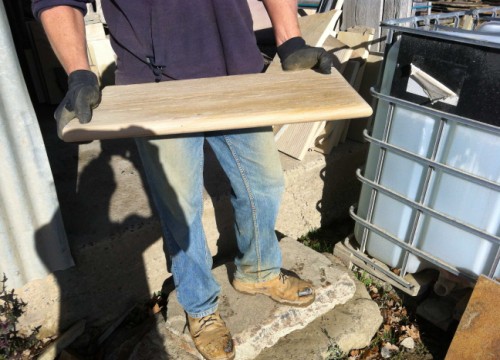
Overall, an angle grinder and diamond blade, hammer, bolster, string line and straight edge or spirit level will be you best friends when working with stone. The string line is a MUST for keeping the level and height of walling and amount of fall for paving. A "plumb bob" is a counter weight attached to a string line used to keep your vertical line straight for high walls, but not a necessity for smaller walls, a spirit level will suffice here. There are a whole lot of other tools and bits and pieces used for various aspects of masonry, such as: diamond buffing pads, diamond tipped drill bits and corers, engraving tools for monumental masons, scutching hammers and chisels or rakes (used to create a natural type edge on saw cut stone) chemical additives for mortar mix which replaces lime, another trick is to use plain old PVC glue! (similar properties) and so on.
Ultimately though, It's just a case of having a good eye for detail and a keen interest in a bit of hard work that will give you a good result, and you can have fun doing it! Experiment a little, creativity goes a long way!!
Final note: For all the ladies out there who think all this stone work might be a man's job.............think again! The most well respected landscaper and user of stone in Australia's modern times, was a lady named Edna Walling. She was more of a designer and wrote plans, but also built walls and paved and has basically set the benchmark for landscapers in this country. Trade schools here still teach her methods to modern landscapers.
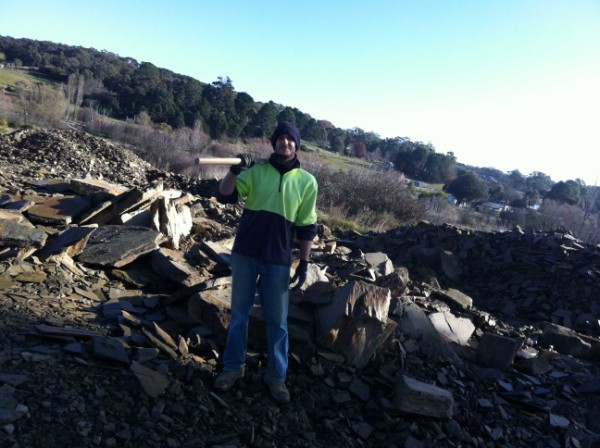
Capping: This is used to finish a wall, whether it be dry stack or mortar joints and you can use thick slabs laid flat on top of the stone, or laid vertically in the case of many old dry stack walls. If laid flat, a nice rough natural edge is great. The slate I use keeps a natural oxidized colour that's quite a bit darker than the stone face or surface. You can use single rectangular pieces if they're wide enough, or even finish the wall with a crazy paving type finish, with the straightest edges facing out and the gaps filled behind with smaller, random pieces.
A rake can be used to shape a cut edge and bull nosing finishes with a rounded, polished edge generally used on uniformed, mortar or dry mortar walls. Some people use a router for bull nosing but I prefer the angle grinder, as the router needs to run along the surface of the stone and if It's not honed (polished) can cause it to bounce and ruin the effect. To do this, simply measure the thickness of stone i.e. if the stone is 50mm thick, draw a line along the edge at the 25mm mark, two more lines at the 12.5mm marks above and below and 25mm back from the edge on the face and bottom of the stone. Use these lines as guides to create half an octagon shape (if viewing down the length of the stone) with your grinder. Then you lightly grind the ridges off the "half octagon" to create a consistent, rounded edge.

Overall, an angle grinder and diamond blade, hammer, bolster, string line and straight edge or spirit level will be you best friends when working with stone. The string line is a MUST for keeping the level and height of walling and amount of fall for paving. A "plumb bob" is a counter weight attached to a string line used to keep your vertical line straight for high walls, but not a necessity for smaller walls, a spirit level will suffice here. There are a whole lot of other tools and bits and pieces used for various aspects of masonry, such as: diamond buffing pads, diamond tipped drill bits and corers, engraving tools for monumental masons, scutching hammers and chisels or rakes (used to create a natural type edge on saw cut stone) chemical additives for mortar mix which replaces lime, another trick is to use plain old PVC glue! (similar properties) and so on.
Ultimately though, It's just a case of having a good eye for detail and a keen interest in a bit of hard work that will give you a good result, and you can have fun doing it! Experiment a little, creativity goes a long way!!
Final note: For all the ladies out there who think all this stone work might be a man's job.............think again! The most well respected landscaper and user of stone in Australia's modern times, was a lady named Edna Walling. She was more of a designer and wrote plans, but also built walls and paved and has basically set the benchmark for landscapers in this country. Trade schools here still teach her methods to modern landscapers.

edit on 29/6/12 by Stonesplitter because: add pics
reply to post by Stonesplitter
Great thread!
Instead of rambling on, you mentioned it being therapeutic. Here's something I posted once before, but it was more in regards to sacred geometry and such...
When this conversation took place with my grandfather, interestingly enough... was the first time he ever told me that he was in fact a mason.
Great thread!
Instead of rambling on, you mentioned it being therapeutic. Here's something I posted once before, but it was more in regards to sacred geometry and such...
In believing that there is an over all governing pattern and relationships between frame of references, self, universe, and governing bodies has helped me understand better the developed philosophies behind those who also practiced 'sacred' geometry.
I find it almost impossible to communicate to others how a philosophy can be derived from playing with geometry. Something that became extremely evident(for me) when in deep thought during various construction jobs, all in regards to masonry. Even now I'm at a lost for words in describing the effects that it had on me. Not gonna lie, it was huge in regards to my understanding of Freemasonry... When I expressed these thoughts and feelings with my grandfather(3rd degree mason) on the relationships between the subjects of philosophy, masonry(profession), and geometry, his immediate response was to invite me into the organization. Which I respectfully declined at the time, but now having second thoughts...
When this conversation took place with my grandfather, interestingly enough... was the first time he ever told me that he was in fact a mason.
Great thread! That is a lot of information... but GREAT information.
Have you ever tried to make or work with adobe bricks? Obviously they are not comparable to stone.
Have you ever tried to make or work with adobe bricks? Obviously they are not comparable to stone.
reply to post by MESSAGEFROMTHESTARS
Thanks mate, much appreciated. He was spot on. It's only natural to feel this way IMO simply because working with nature in this way calms the soul. Sacred geometry is the link to the Universe.........everything being connected, at ONE so to speak or even a form of waking meditation. It certainly keeps me focused!
Edit: A book I've read a couple of times called "Along the New Silk Road", absolutely awesome reading touches on this quite a bit.
Thanks mate, much appreciated. He was spot on. It's only natural to feel this way IMO simply because working with nature in this way calms the soul. Sacred geometry is the link to the Universe.........everything being connected, at ONE so to speak or even a form of waking meditation. It certainly keeps me focused!
Edit: A book I've read a couple of times called "Along the New Silk Road", absolutely awesome reading touches on this quite a bit.
edit on
29/6/12 by Stonesplitter because: book reference
reply to post by Catalyst317
Thanks Catalyst! I never really play around with Adobe, but I still give Soundforge AcidDJ a whirl from time to time!
Different, I know......but being creative with anything is a good thing. I used to love doing Art and Graphics back in school days, but never really knew what I wanted to do with it. I entered the printing industry for a few years, completed an apprenticeship, but hated it ......I eventually found my niche with stone work and never looked back.
Thanks Catalyst! I never really play around with Adobe, but I still give Soundforge AcidDJ a whirl from time to time!
Different, I know......but being creative with anything is a good thing. I used to love doing Art and Graphics back in school days, but never really knew what I wanted to do with it. I entered the printing industry for a few years, completed an apprenticeship, but hated it ......I eventually found my niche with stone work and never looked back.
Very interesting topic, and thanks for the nice pictures. Wish I had not two left hands, but unless you give me an apparatus that can be utilized with
a mouse and keyboard I am no good at any craftsmanship.
Did you ever hold a geiger-counter to your slate ? You might be surprised : )
Did you ever hold a geiger-counter to your slate ? You might be surprised : )
reply to post by H1ght3chHippie
Thanks mate. Yeah, I believe granite has trace amounts of radioactivity, although I'm told It's so low that it has no real effect..........but ask me again in a few years when I have no hair and complaining "What's that strange rash??!!"
Thanks mate. Yeah, I believe granite has trace amounts of radioactivity, although I'm told It's so low that it has no real effect..........but ask me again in a few years when I have no hair and complaining "What's that strange rash??!!"
Thanks for posting really great informative thread my hubby is a landscaper venturing into
walkways and dry stone walls I will show him your thread he will be highly interested.
Some people have this amazing ability just to pick up a stone and place it I think this is a beautiful art you either have it or you don't.I guess you can learn but it's just not the same.
I think my hubby has it. Thanks for posting once again! S+F
walkways and dry stone walls I will show him your thread he will be highly interested.
Some people have this amazing ability just to pick up a stone and place it I think this is a beautiful art you either have it or you don't.I guess you can learn but it's just not the same.
I think my hubby has it. Thanks for posting once again! S+F
Hey, you are a Rock a fella.
My grandfather was a stone cutter. He made gravestones.
Our families business was selling gravestones.
Good times.....
My grandfather was a stone cutter. He made gravestones.
Our families business was selling gravestones.
Good times.....
All very impressive, but where's the SHTF or Survival angle?
Is it that stone would be a good building material after such an event? Wouldn't concrete be easier to use, transport, and work with, without modern equipment? The ancients had the manpower of slaves to work with stone...if anything, we'd be faced with a smaller pool of such manpower.
There's no doubting the long-lasting quality of stone, but I'd have to think concrete would net many of the same results, in a survival situation.
Is it that stone would be a good building material after such an event? Wouldn't concrete be easier to use, transport, and work with, without modern equipment? The ancients had the manpower of slaves to work with stone...if anything, we'd be faced with a smaller pool of such manpower.
There's no doubting the long-lasting quality of stone, but I'd have to think concrete would net many of the same results, in a survival situation.
reply to post by Gazrok
Look at it this way............in a SHTF scenario, rocks will still be around everywhere. But who is going to make your cement? Do you think you can just pop down to the local hardware store and pick up some more concrete? Unless you stockpile this, you could kiln your own cement........but do you have a kiln? The temperatures used are around 1000 degrees!
Look at it this way............in a SHTF scenario, rocks will still be around everywhere. But who is going to make your cement? Do you think you can just pop down to the local hardware store and pick up some more concrete? Unless you stockpile this, you could kiln your own cement........but do you have a kiln? The temperatures used are around 1000 degrees!
reply to post by karen61057
Must be a different bloodline........I actually help people!
And yeah, monumental masons do great business, you see that's the problem.........people keep DYING!
Must be a different bloodline........I actually help people!
And yeah, monumental masons do great business, you see that's the problem.........people keep DYING!
reply to post by starlitestarbrite
Excellent mate, that' one thing I recommend to people who are looking to get out of the old 9 to 5 routine. Landscapers down here generally always have work, especially in developing areas.
Excellent mate, that' one thing I recommend to people who are looking to get out of the old 9 to 5 routine. Landscapers down here generally always have work, especially in developing areas.
reply to post by Stonesplitter
Thats why they had to put fences around all the cemetaries. People were dying to get in .. LOL. Old joke I know. I'm an old gal.
Thats why they had to put fences around all the cemetaries. People were dying to get in .. LOL. Old joke I know. I'm an old gal.
Cool, I do brick masonry.
i15.photobucket.com...
i15.photobucket.com...
Structural stuff mostly.
i15.photobucket.com...
i15.photobucket.com...
i15.photobucket.com...
i15.photobucket.com...
Structural stuff mostly.
i15.photobucket.com...
i15.photobucket.com...
edit on 30-6-2012 by BrutalDictator because: (no reason given)
reply to post by BrutalDictator
Nice mate. Having that construction experience makes it easier to cross over into other fields. The bessa blocks you've pictured can also be used as a sub frame for stone walls. Just bed them in the shape of the wall you want, fill them with concrete, then you can use either thin veneer to clad them, or build up your pitchers or "strata" against them.
Nice mate. Having that construction experience makes it easier to cross over into other fields. The bessa blocks you've pictured can also be used as a sub frame for stone walls. Just bed them in the shape of the wall you want, fill them with concrete, then you can use either thin veneer to clad them, or build up your pitchers or "strata" against them.
Really great thread and looks like it will answer some questions I've had about working with stone. In a SHTF situation being able to work with a
durable and tough material would be invaluable.
reply to post by Domo1
Thanks very much mate, more than happy to help. It's definitely worth having some understanding of this type of work......you never know when you might need it!
Edit: Just another vid on trimming flagstones
Thanks very much mate, more than happy to help. It's definitely worth having some understanding of this type of work......you never know when you might need it!
Edit: Just another vid on trimming flagstones
edit on 30/6/12 by Stonesplitter because: add
vid
new topics
-
George Knapp AMA on DI
Area 51 and other Facilities: 12 minutes ago -
Not Aliens but a Nazi Occult Inspired and then Science Rendered Design.
Aliens and UFOs: 21 minutes ago -
Louisiana Lawmakers Seek to Limit Public Access to Government Records
Political Issues: 2 hours ago -
The Tories may be wiped out after the Election - Serves them Right
Regional Politics: 3 hours ago -
So I saw about 30 UFOs in formation last night.
Aliens and UFOs: 5 hours ago -
Do we live in a simulation similar to The Matrix 1999?
ATS Skunk Works: 6 hours ago -
BREAKING: O’Keefe Media Uncovers who is really running the White House
US Political Madness: 7 hours ago -
Biden--My Uncle Was Eaten By Cannibals
US Political Madness: 8 hours ago -
"We're All Hamas" Heard at Columbia University Protests
Social Issues and Civil Unrest: 8 hours ago -
The good, the Bad and the Ugly!
Diseases and Pandemics: 10 hours ago
top topics
-
BREAKING: O’Keefe Media Uncovers who is really running the White House
US Political Madness: 7 hours ago, 22 flags -
Biden--My Uncle Was Eaten By Cannibals
US Political Madness: 8 hours ago, 18 flags -
African "Newcomers" Tell NYC They Don't Like the Free Food or Shelter They've Been Given
Social Issues and Civil Unrest: 13 hours ago, 12 flags -
George Knapp AMA on DI
Area 51 and other Facilities: 12 minutes ago, 8 flags -
Two Serious Crimes Committed by President JOE BIDEN that are Easy to Impeach Him For.
US Political Madness: 16 hours ago, 8 flags -
911 emergency lines are DOWN across multiple states
Breaking Alternative News: 16 hours ago, 7 flags -
"We're All Hamas" Heard at Columbia University Protests
Social Issues and Civil Unrest: 8 hours ago, 7 flags -
Russia Flooding
Fragile Earth: 14 hours ago, 6 flags -
Russian intelligence officer: explosions at defense factories in the USA and Wales may be sabotage
Weaponry: 12 hours ago, 5 flags -
So I saw about 30 UFOs in formation last night.
Aliens and UFOs: 5 hours ago, 4 flags
active topics
-
"We're All Hamas" Heard at Columbia University Protests
Social Issues and Civil Unrest • 105 • : marg6043 -
So I saw about 30 UFOs in formation last night.
Aliens and UFOs • 15 • : Arbitrageur -
Candidate TRUMP Now Has Crazy Judge JUAN MERCHAN After Him - The Stormy Daniels Hush-Money Case.
Political Conspiracies • 356 • : YourFaceAgain -
The Acronym Game .. Pt.3
General Chit Chat • 7726 • : bally001 -
Russian intelligence officer: explosions at defense factories in the USA and Wales may be sabotage
Weaponry • 160 • : BernnieJGato -
Biden--My Uncle Was Eaten By Cannibals
US Political Madness • 38 • : YourFaceAgain -
George Knapp AMA on DI
Area 51 and other Facilities • 1 • : pianopraze -
Senti L'Estate Che Torna - Music From Italy
Music • 39 • : Hellmutt -
Not Aliens but a Nazi Occult Inspired and then Science Rendered Design.
Aliens and UFOs • 1 • : JonnyC555 -
BREAKING: O’Keefe Media Uncovers who is really running the White House
US Political Madness • 10 • : TzarChasm
